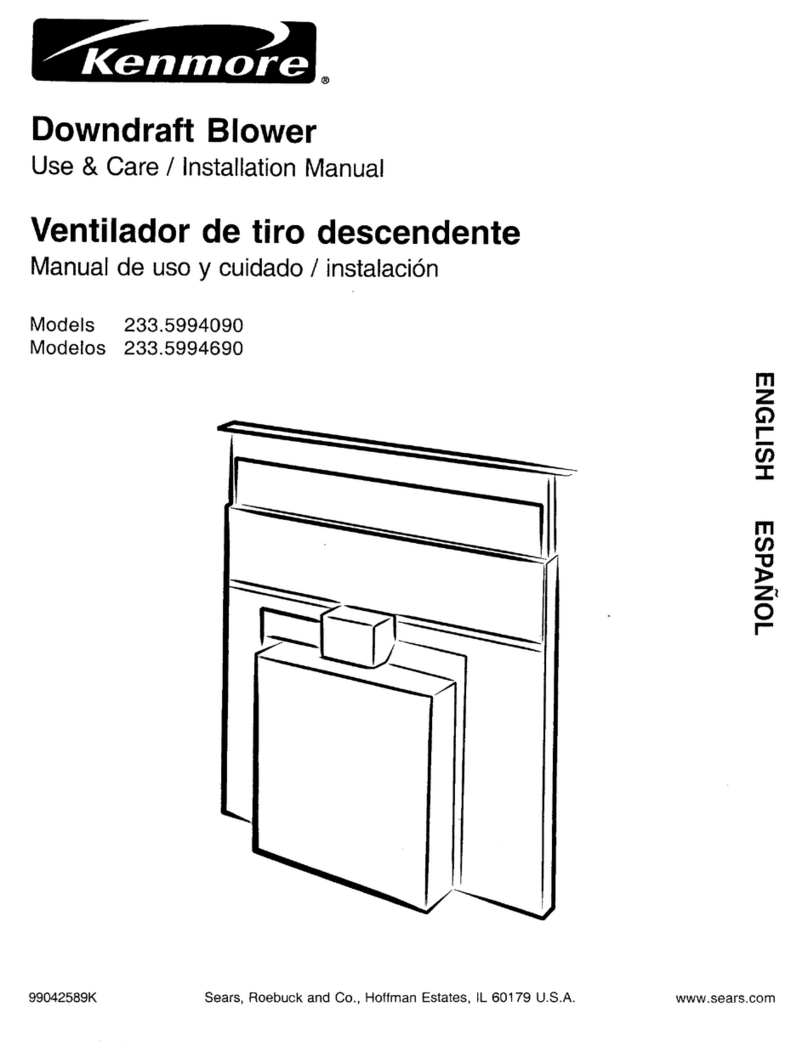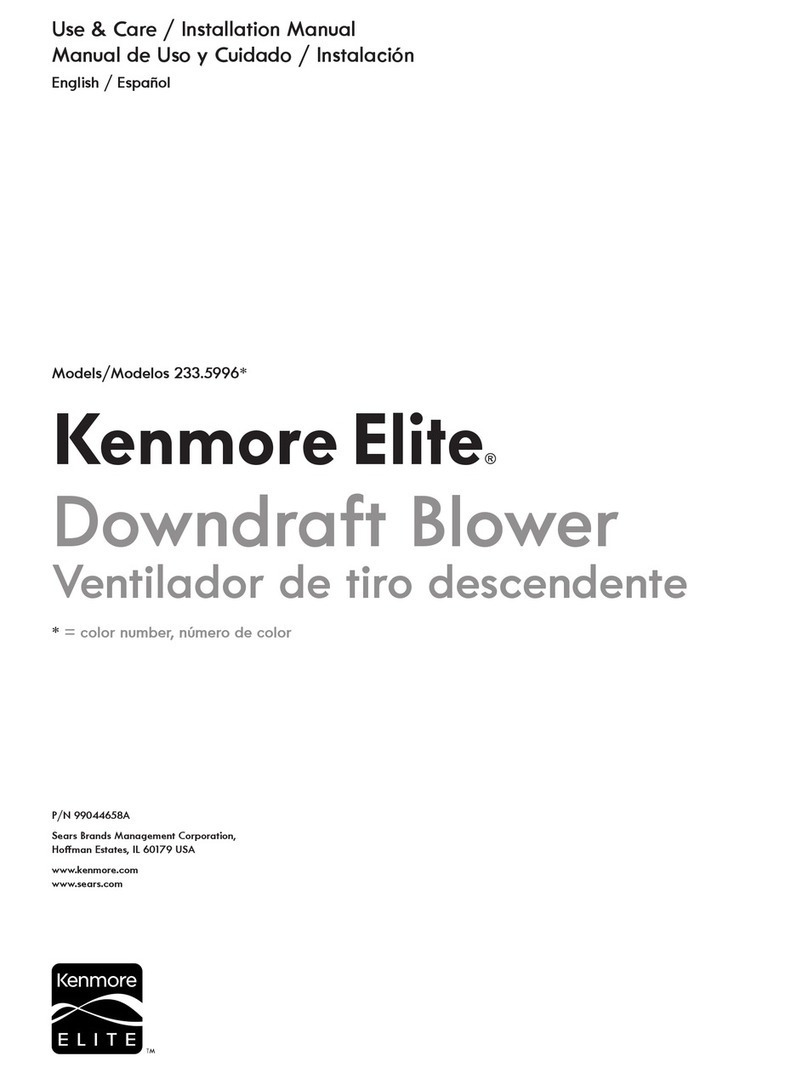
2
WARNING
TO REDUCE THE RISK OF FIRE, ELECTRIC SHOCK, OR
INJURY TO PERSONS, OBSERVE THE FOLLOWING:
1. Use this unit only in the manner intended by the manufacturer.
If you have questions, contact the manufacturer at the
address listed in the warranty.
2. Before servicing or cleaning unit, switch power off at service
panel and lock the service disconnecting means to prevent
power from being switched on accidentally. When the
service disconnecting means cannot be locked, securely
fasten a prominent warning device, such as a tag, to the
service panel.
3. Installation work and electrical wiring must be done by a
qualified person(s) in accordance with all applicable codes
and standards, including fire-rated codes and standards.
4. Sufficient air is needed for proper combustion and
exhausting of gases through the flue (chimney) of fuel
burning equipment to prevent backdrafting. Follow the
heating equipment manufacturer’s guideline and safety
standards such as those published by the National Fire
Protection Association (NFPA), and the American Society
for Heating, Refrigeration and Air Conditioning Engineers
(ASHRAE), and the local code authorities.
5. When cutting or drilling into wall or ceiling, do not damage
electrical wiring and other hidden utilities.
6. Do not use this unit with an additional speed control device.
7. Ducted fans must always be vented to the outdoors.
8. To reduce the risk of fire, use only metal ductwork.
9. Do not install this product with the activating switch directly
behind a burner or element. Minimum distance between the
switch and the edge of the burner should be 4 inches.
10. Loose-fitting or hanging clothing should never be worn when
operating this appliance. They may be ignited by burners/
elements on cooktop.
11. Children should not be left alone or unattended in the area
where this appliance is in use.
12. This unit must be grounded.
WARNING
TO REDUCE THE RISK OF A RANGE TOP GREASE FIRE:
1. Never leave surface units unattended at high settings.
Boilovers cause smoking and greasy spillovers that may
ignite. Heat oils slowly on low or medium settings.
2. Always turn hood ON when cooking at high heat or when
cooking flaming foods.
3. Clean ventilating fans frequently. Grease should not be
allowed to accumulate on fan or filter.
4. Use proper pan size. Always use cookware appropriate for
the size of the surface element.
TO REDUCE THE RISK OF INJURY TO PERSONS IN THE
EVENT OF A RANGE TOP GREASE FIRE, OBSERVE THE
FOLLOWING:*
1. SMOTHER FLAMES with a close-fitting lid, cookie sheet,
or metal tray, then turn off the burner. BE CAREFUL TO
PREVENT BURNS. If the flames do not go out immediately,
EVACUATE AND CALL THE FIRE DEPARTMENT.
2. NEVER PICK UP A FLAMING PAN - You may be burned.
3. DO NOT USE WATER, including wet dishcloths or towels - a
violent steam explosion will result.
4. Use an extinguisher ONLY if:
A. You know you have a Class ABC extinguisher and you
already know how to operate it.
B. The fire is small and contained in the area where it
started.
C. The fire department is being called.
D. You can fight the fire with your back to an exit.
* Based on “Kitchen Firesafety Tips” published by NFPA.
CAUTION
1. For general ventilating use only. Do not use to exhaust
hazardous or explosive materials and vapors.
2. To avoid motor bearing damage and noisy and/or
unbalanced impellers, keep drywall spray, construction dust,
etc. off power unit.
3. Clean filters and grease-laden surfaces frequently.
4. Do not repair or replace any part of this appliance unless
specifically recommended in this manual. All other servicing
should be done by a qualified technician.
5. Please read specification label on product for further
information and requirements.
SAFETY INSTRUCTIONS
!
TABLE OF CONTENTS WARRANTY
SECTION .......................................................................PAGE
Warranty ................................................................................2
Safety Instructions .................................................................2
Operation ...............................................................................3
Cleaning, Servicing................................................................3
Parts Included With Downdraft ..............................................4
Tools Needed For Installation ................................................4
Equivalent Duct Length Chart ................................................5
Prepare The Downdraft Location ...........................................6
Prepare The Downdraft ..........................................................7
Install The Downdraft .............................................................8
Connect The Wiring ...............................................................9
Complete The Installation ....................................................10
Master Protection Agreements .............................................10
Service Parts ....................................................................... 11
If within 1 year from the date of installation, any part of this
downdraft fails to function properly due to a defect in mate-
rial or workmanship, Sears will repair the part or furnish and
install a new part, free of charge.
FULL 30-DAY WARRANTY ON FINISH ON PAINTED OR
BRIGHT METAL PARTS
If within 30 days from the date of installation, the finish on
any painted or bright metal parts of this downdraft is defective
in material or workmanship, Sears will furnish and install a
new part, free of charge.
WARRANTY SERVICE IS AVAILABLE BY CONTACTING
THE NEAREST SEARS SEVICE CENTER/DEPARTMENT
IN THE UNITED STATES.
This warranty applies only while this product is in use in the
United States. This warranty gives you specific legal rights
and you may have other rights which vary from state to state.
Sears, Roebuck and Co., Dept 817WA, Hoffman Estates,
IL 60179
!
INTENDED FOR DOMESTIC COOKING ONLY
!
READ AND SAVE THESE INSTRUCTIONS





























